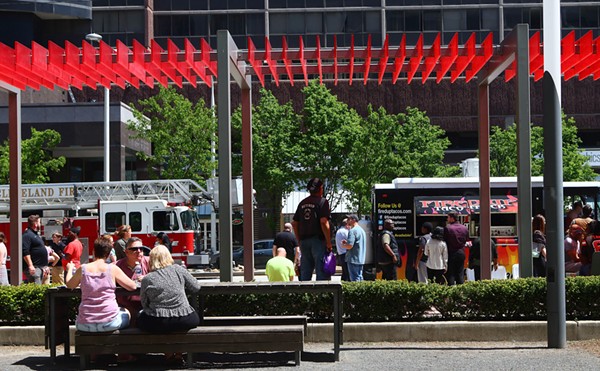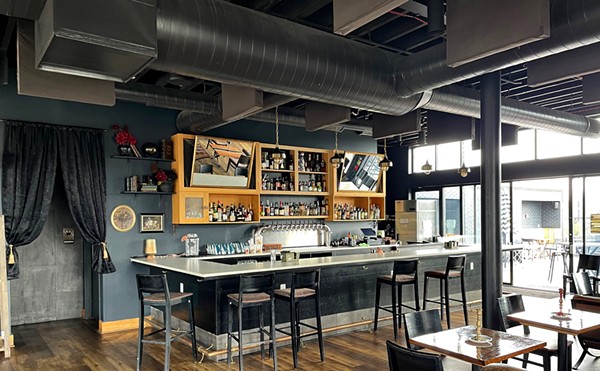To get to the restaurant's curing room, the chef led me down a staircase, through a mechanical room, finally stopping in a dimly lit back hallway. There, he moved aside a tall stack of cardboard boxes and other items that were carefully arranged to conceal a walk-in cooler. When he flung open the door I was immediately struck by the unmistakable smell of funk and mold that accompanies slowly ripening charcuterie.
Like many restaurants that offer housemade charcuterie, this one does so without the grace and consent of the governmental agencies tasked with overseeing food safety, which is why I was asked not to reveal its identity. This is not to say that the cured meats being consumed here by diners are unsafe; it's just that the chef could not or chose not to undertake the onerous process of going legit. Others opted for transparency.
"I started making charcuterie and salumi in the restaurant when we started our whole-animal butchering program," explains Nate Fagnilli, owner of Crosswinds Grille at The Lakehouse Inn in Geneva-on-the-Lake. "And we were very much like a lot of people at the time, meaning I spent a year of my life looking over my shoulder waiting to get busted. It's a lot like making moonshine."
Fagnilli wanted to walk the straight and narrow, so he took the considerable time, effort and money required to file the required paperwork, which involves preparing the maddeningly complex Hazard Analysis and Critical Control Point (HACCP) plan that addresses food safety hazards.
"To sit down and do a HACCP plan with all supporting documents is very time consuming," he reports. "You're talking about a document that took me two years to write and cost me a lot of money, with a street value of probably $20,000. That's why most restaurants and butcher shops don't do it, because it's a lot of friggin' work."
But Fagnilli went well above the legal threshold when he opened NaKyrsie Meats (100 Austin Rd., Geneva, 440-415-3546, nkmeats.com) last year with his wife Kristin. As an Ohio Department of Agriculture-inspected meat processor, Fagnilli can sell and distribute his raw meat and charcuterie products statewide, making him one of just three such businesses in the state.
Fagnilli brings in whole grass-fed cows, heritage-breed pigs and pastured chickens from small family farms like New Creation, Miller Livestock and Henry Farms. His lab-coated butchers work in a clean, cold room to break down the animals using Old-World seam butchery techniques. Whole bacons go into the smoker. Whole-muscle cuts like beef eye round, pork loin and ham are rubbed with salt and spices and stowed in a temperature- and humidity-controlled curing chamber for weeks, months and even a year or longer until they come out the other end as bresaola, lonza and prosciutto. Ground, spiced and stuffed charcuterie like Genoa salami, soppressata, andouille and saucisson require the extra step of fermentation before hanging to dry and cure.
"Fermenting is a lethality step," Fagnilli explains. "Fermenting introduces an acid (that pleasant tang in a summer sausage) that is sour enough to kill any harmful microorganisms. It acidulates the product to reach a certain pH, like they used to do by adding wine."
Fagnilli accomplishes the same level of food safety through techniques like fermentation, salting and dry-curing (and the judicious use of sodium nitrite, which prevents botulism) that others achieve through cooking, but with none of the undesirable results.
"When you heat-treat ham, it's no longer ham; it's roasted pork," he says. "Cooking items like bologna, salami and ham completely changes the color, texture and flavor of those foods."
NaKyrsie Meats are found on menus all over town, including Rennick Meat Market in Ashtabula, Fire Food and Drink in Cleveland, and Warren's Spirited Kitchen in Burton.
"When it comes to charcuterie, he's the gold standard," says Cleveland chef Jeremy Umansky. "Not only does he have a head start on everybody else, but his product will always be considered the flagship."
As a commercial butcher shop, NaKyrsie also sells more conventional items like burgers, chicken, dry-aged strip steaks, whole briskets and pork chops ringed with a thick, creamy layer of fat. Lesser-known cuts like Ranch, Denver and Bavette steaks join even rarer items like beef "oysters" from the groin and pork heels off the calf muscle.
So, knowing what he knows now about the risks associated with underground charcuterie, does Fagnilli still order the meat board at local bistros?
"I absolutely would," he says. "It's a risk that I'm willing to take. I guess it could be looked at as a little foolish, but so is eating a raw oyster or a rare hamburger from an unknown place. If these chefs follow the rules, their charcuterie is probably pretty safe."









